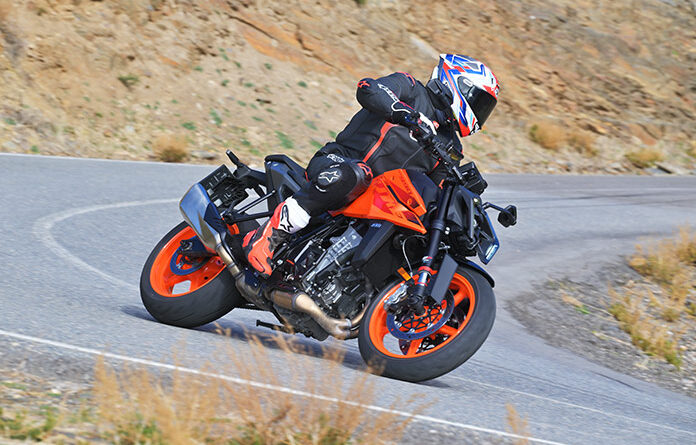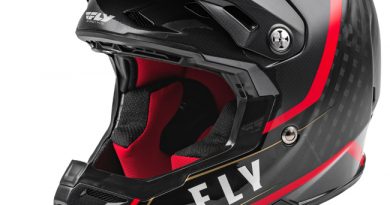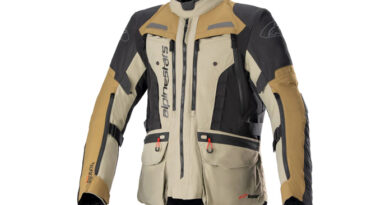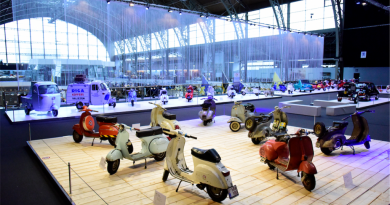2024 KTM 990 Duke Review | First Ride
What’s the magic number? When the first Duke debuted 30 years ago, it was 602cc, which was packed into a single-cylinder engine that made 58 hp. These days (in the U.S. market), Dukes range in displacement from 249cc in the Duke 250 to 1,350cc in the 1390 Super Duke R Evo. In between, KTM offers the 390 Duke (399cc), 790 Duke (799cc), and 990 Duke (947cc). For this KTM 990 Duke review, we take one of the newest Dukes on a test ride in the mountains of southern Spain.
Related: 2024 KTM 390 Duke Review | First Ride
With its displacement approaching a liter, the new 990 Duke resides in the so-called “super middleweight” class. It replaces the 890 Duke R, but there’s more to it than just a 58cc bump in engine size. According to KTM reps at the global launch in Spain, the 990 Duke is 96% new and “more like a smaller Super Duke.”
Powering the 990 Duke is KTM’s liquid-cooled LC8c parallel-Twin with DOHC and 4 valves per cylinder – the same engine platform found across the 790/890/990 Adventure and Duke lines. Only the 990 Duke has the 947cc version that makes a claimed 123 hp at 9,500 rpm and 76 lb-ft of torque at 6,750 rpm (up from 121 hp and 73 lb-ft on the 890 Duke R). The intake mixture is fed through a 46mm throttle body and compressed at a ratio of 13.5:1, the Bosch engine management system uses throttle-by-wire, and the 6-speed transmission is mated to a PASC slip/assist wet clutch. Spent gasses exit through a new stainless-steel exhaust that’s Euro 5+ compliant.
Wrapped around the 990 Duke’s engine is a new frame, subframe, and swingarm. The chromoly steel frame, which uses the engine as a stressed member, is stiffer for added stability and wider at the back to pass outside rather than inside the swingarm. To compensate for the stiffer frame, the diecast aluminum subframe allows more flex, and it now houses the airbox. The swingarm, which is constructed using gravity diecast aluminum and uses a closed-lattice rather than the previous open-lattice design, is 3.3 lb lighter than the 890 Duke R’s. Curb weight with the 3.8-gallon tank fuel is a svelte 395 lb.
Gear Up | KTM 990 Duke Review
Helmet: Shoei X-Fifteen
Suit: Alpinestars Missile V2
Airbag Vest: Alpinestars Tech-Air 5
Gloves: Alpinestars SP-8 V3 Air
Boots: Alpinestars Supertech R Vented
Like the 890 Duke R, the 990 Duke is equipped with adjustable WP Apex suspension, but it has a new 43mm inverted open-cartridge fork with 5.5 inches of travel and a single gas-assisted rear shock that’s mounted directly to the top of the swingarm and has 5.9 inches of travel. Convenient fork-top adjusters offer five-click adjustability for compression (left leg) and rebound (right leg). The shock also has a five-position adjuster for rebound that requires a flat-blade screwdriver, and preload is adjustable using a spanner (both tools are in a kit under the seat; compression cannot be adjusted).
The 990 Duke rolls on 17-inch cast-aluminum wheels shod with Bridgestone Battlax S22 tires (the latest S23s weren’t yet available for homologation). The front wheel is the same as the 1390 Super Duke R Evo’s, but the rear is slightly different because the 990 has a two-sided swingarm and the 1390 has a single-sided swingarm. Slowing things down are the same 4-piston radial front calipers with 300mm discs and 2-piston rear calipers with a 240mm disc as on the 890 Duke R, but a lighter connection between the front rotors and the wheel saves roughly 2.2 lb of unsprung weight. Cornering ABS with a rear-off Supermoto mode is standard.
In terms of technology, the 990 Duke has a new 5-inch color TFT display with a scratch- and glare-resistant bonded-glass screen, redesigned menus, and optional KTMconnect for smartphone pairing to allow access to navigation, audio, and phone calls. All lighting is LED and there’s a USB-C charging port. Rider electronics include three standard ride modes (Sport, Street, and Rain) and two optional ride modes (Performance and Track) that adjust throttle response, lean-sensitive traction control, and wheelie control. Track mode enables a10-level rear-wheel slip adjuster that can be adjusted on the fly, launch control, a lap timer, and telemetry functions. Cruise control, Motor Slip Regulation, and an up/down quickshifter are optional.
The 990 Duke has also been restyled, with a more muscular, hunched-forward stance like the 1390 Super Duke R Evo. Both share a unique headlight design with stacked low and high beams in the center that are framed by a pair of DRLs shaped like curved talons. Compared to the 890 Duke R, the 990 Duke’s seat is angled up more in the front to prevent the rider sliding forward, is flatter, has new foam, and sits at 32.4 inches, down from 32.8 on the 890. The pillion seat was moved up by 0.8 inch to give the passenger a better view and more legroom.
My test ride on the 990 Duke was a romp in mountains above Almería, Spain, on a cold, clear February morning that was part of the “30 Years of Duke” press launch that included the 390 Duke and 1390 Super Duke R Evo. When we did a comparison test of KTM’s full Duke lineup in 2021, the 890 Duke was a staff favorite, “a standout machine that encourages you to test its handling and your nerve, and it consistently rewards the rider with confidence-inspiring feel and agility or a gentle prod where lesser machines fall short.” We described it as “a mustang, wild at heart, straining at the bit, and embodies the essence of the Duke series: immediate power and razor-sharp cornering stripped down to the barest of essentials.”
Is the 990 Duke even better? Yes and no. It is an exciting machine that provides a thrilling rush of power and has a light and balanced feel, a responsive chassis, and an excellent electronics package. The Duke’s steady evolution from the 790 to the 890 to the 990 is obvious, but the 990 feels like it just turned 40, suddenly thrust into middle age. As a seven-tenths scale Super Duke (at least in terms of engine displacement; the 990’s 123 hp is 65% as much as the 1390’s 190 hp), it demands more respect and has lost a bit of its free-spiritedness.
That’s not necessarily a bad thing. It’s just a shift in focus, and with the 790 Duke back in KTM’s lineup, it makes sense.
Our launch base camp was the Circuito de Almería, located in an arid region near the southern Spanish coast where many Spaghetti Westerns were filmed. From the track, we rode north into the mountains, climbing rapidly on a road with so many hairpins it felt like riding the Alps minus the tour buses. On such a tight, technical road, the 990 Duke felt like overkill. The 390 Duke we rode the previous day would have made more sense, or perhaps KTM’s 690 SMC R supermoto.
After we did our photo passes on a 1st-gear hairpin where I struggled to find my groove, we continued climbing to the top of the mountain. Down the other side, the curves opened up and the 990 Duke felt more in its element.
On a short ride on public roads, some of which were wet or lightly glazed with ice, I didn’t try out the Performance or Track modes, or the new launch control. The Street and Sport modes provided plenty of excitement, and the more I rode the 990 Duke, the more I fell under its spell. Allow me to reiterate two key specs: 123 hp and 395 lb. That power is delivered in a direct but very manageable way to the rear wheel, which is attached to a lightweight motorcycle with a retuned chassis that ensures steering inputs hit the bullseye. Admirable qualities, but also ones that encourage a high rate of speed.
I’ve tested enough KTMs to become accustomed to its menus and appreciate the intuitive illustrated motorcycle graphics that show how different settings affect vehicle dynamics. The new switchgear on the 990 Duke is easy to use, but there are too many steps involved in changing modes and settings on the fly. A simple “mode” button that would allow a rider to quickly toggle between ride modes would simplify the process.
So 990 may be the magic number. Nearly 20 years ago, the KTM 990 Super Duke was the first big-bore streetbike made by a small Austrian company known for its dirtbikes. Since then, KTM has become Europe’s largest motorcycle manufacturer, the Super Duke has gotten super-er, and the 990 Duke honors that legacy.
2024 KTM 990 Duke Specs
Base Price: $12,500
Website: KTM.com
Warranty: 2 yrs., 24,000 miles
Engine Type: Liquid-cooled, transverse parallel-Twin, DOHC w/ 4 valves per cyl.
Displacement: 947cc
Bore x Stroke: 92.5 x 70.4mm
Horsepower: 123 hp @ 9,500 rpm (factory claim)
Torque: 76 lb-ft @ 6,750 rpm (factory claim)
Transmission: 6-speed, cable-actuated slip/assist wet clutch
Final Drive: Chain
Wheelbase: 58.1 in.
Rake/Trail: 24.2 degrees/3.9 in.
Seat Height: 32.5 in.
Wet Weight: 395 lb (factory claim)
Fuel Capacity: 3.9 gal.
Fuel Consumption: 50 mpg (factory claim)
The post 2024 KTM 990 Duke Review | First Ride appeared first on Rider Magazine.




